
Brief:
The Centuri X-21 is a very pretty rear engine boost-glider with a payload
section. Boost-to-glide transition is performed by ejecting the engine and
raising elevons. Centuri offered this as a kit from 1964 to 1969. Building
notes and discussion are posted in a dedicated thread at
Ye Olde Rocket Forum.
Construction:
The parts list:
- 1 5" BT-20 body tube (Centuri ST-75)
- 1 3.3" long nose cone for BT-20 (Centuri BC-76)
- 5 3" x 11" x 1/16" balsa sheet
- 1 2" of BT-20 size clear plastic tube
- 1 1" solid balsa tube connector for BT-20 (Centuri BTC-7)
- 1 0.5 " solid balsa tube connector for BT-20 (Half of BTC-7)
- 1 1.75" x 1/8" dia. launch lug (Centuri LL-1)
- 1 screw eye
- 2 3/16" x 2" strip of adhesive-backed paper label
- 2 1" x 5.5" pieces of Tyvek paper
- 1 6" of elastic thread
- 1 8" of crochet twine or sewing thread
- 1 "release clip"
Most of the above parts can be purchased from Semroc or Balsa Machining Services. I did not get them from either place though, preferring to use parts and materials available locally. The nose cone and tube connectors were turned from balsa blocks on a toy lathe. The clear tube was cut from the payload tube of an Estes 0834 X-Ray kit. The release clip was fashioned from the popped-down hole panel of a soda can, cut with tin snips and bent and crimped shape with pliers.
So far (as of the fall of 2005), the X-21 documentation at Ye Olde Rocket Shoppe includes Centuri's original Assembly Drawings and Assembly instructions. Printed at full scale, these require 11"x17" sheets. When fitted to 8.5" x 14" sheets, they are adequate and readable, though the text is pretty tiny. The patterns fit nicely on 8.5" x 14" sheets at full scale.
The Assembly Drawing includes a parts list that does not list Centuri part numbers or specify any dimensions. Lengths of the body tubes were deduced by measuring root edges of the wing/fin patterns and observing relative fit on the assembly drawing. Launch lug and nose cone dimensions were found by scaling Assembly Drawing measurements and finding appropriate parts from Centuri Catalogs viewed on Sven Knudson's Ninfinger website. Balsa sheet thickness was deduced as 1/16" by measuring the Under Wing Runner mark on the Wing pattern.
Obscure parts included the "control stop", the "V-slot guide", and the "release clip". There are no patterns or detailed descriptions of these parts, so some creative compromises were required.
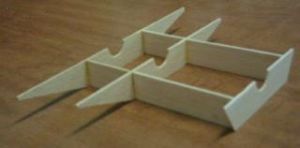 The plans
include a wing mounting jig that helped greatly for mounting the wings and
payload fins and for supporting the model while attaching parts to the under
wing side of the model. Also included was a stabilizer angle template that was
useful for mounting the large wingtip stabilizers.
The plans
include a wing mounting jig that helped greatly for mounting the wings and
payload fins and for supporting the model while attaching parts to the under
wing side of the model. Also included was a stabilizer angle template that was
useful for mounting the large wingtip stabilizers.
According to the patterns, the root edge of the Main Wing is 5" long. From the Assembly Diagram, the main body tube appears to be a BT-20 that is 5-1/4" to 5-3/16" long. However, the instructions specify that the motor block is mounted one full engine length in the main body tube. I prefer being able to grip the back end of the motor in case I have to pull it out of there, so I cut the main body to 5" long, mounted the motor block with 3/16" of the motor sticking out, and mounted the wings 3/16" back from the front of the main body.
One of the things I'd noticed is that the wing section could be cut out as one piece instead of as three (Main Wing, Insert, and Runner pieces) by using 4" wide balsa. This simplifies assembly and, I think, strengthens the rear edge of the wing with a better grain orientation. In retrospect, I think that leaving the runner as a separate piece might have been a better idea so that the runner would help prevent the wing from warping.
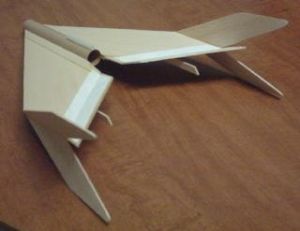 For the elevon
hinges, I used material cut out of a Tyvek shipping envelope, attaching it to
the wing and elevon with white glue. I heartily recommend this stuff as hinge
material. It's super cheap, extremely tough, pliable and flexible as paper, and
glues down well.
For the elevon
hinges, I used material cut out of a Tyvek shipping envelope, attaching it to
the wing and elevon with white glue. I heartily recommend this stuff as hinge
material. It's super cheap, extremely tough, pliable and flexible as paper, and
glues down well.
The "control stops" appear to have originally been factory assembled parts that were angled wires swiveling within thin aluminum tubes. I substituted some fairly stiff wire glued directly to the stablizer-wing joints. This appears to work very well, requiring the use of pliers to adjust elevon stop heights.
The "release clip" attaches to the "neutral elevon release" thread. It is a key part of the elevon control mechanism for this model. An elastic on the top wing side raises the elevons to glide position. During boost, the elevons are held flat by a "neutral elevon release" thread under the wing. To do this, the threads are pulled tight by the "release clip" that is friction-fitted between the engine and the body tube. When the engine ejects, the "release clip" releases tension on the "neutral elevon release" thread, allowing the elastic to raise the elevons.
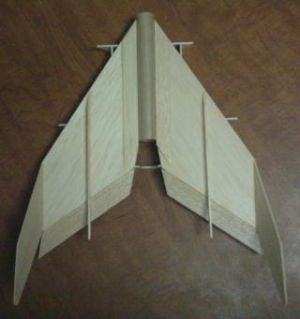 To form a
"release clip", I cut a 3/4" x 1/8" piece of thin metal
from the popped down hole panel of a soda can. I folded about 1/16" of one
end of the strip over the center of the "neutral elevon release"
thread with pliers. I clipped corners off of the other end of the strip to ease
insertion between the motor and the body tube.
To form a
"release clip", I cut a 3/4" x 1/8" piece of thin metal
from the popped down hole panel of a soda can. I folded about 1/16" of one
end of the strip over the center of the "neutral elevon release"
thread with pliers. I clipped corners off of the other end of the strip to ease
insertion between the motor and the body tube.
I cut a V shape into the above wing motor end of the body tube to aid insertion of the "release clip".
Other than the above exceptions, the Assembly Instructions and Assembly Drawings were clear, precise, and straightforward. Construction of the payload section was poorly described other than a description of how to attach the payload section fins. Assembly of this section is just a matter of inserting the nose cone and the balsa tube connector, but this process should certainly have been discussed.
The model was fun but a bit awkward to adjust glide trim. There's no good place near the model's CG to grasp, so you need to kind of propel it in the right direction by pushing the back end of the body tube.
Although the Assembly Instructions indicate that a weight is required for stable flight, my model swing tested perfectly with no added ballast or payload weight.
Finishing:
The balsa surface area of this model is vast! You sure find out when you start
sanding to smooth surfaces and round off leading edges. The Assembly
Instructions advise don't mention sanding sealer and don't say much about
applying paint, they only advise against using heavy enamels, suggesting a
light coat of spray lacquer or lacquer enamel.
At article submission time, I've only flown the X-21 completely naked (I missed by "Flying Nikkei" photo contest by a few weeks!). When spring 2006 arrives, I intend to apply sanding sealer, and maybe add some color in some manner. I'm very reluctant to add much weight to this beauty.
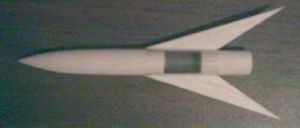 And what a
beauty it is! I love the unique look of the X-21, with its acres of balsa
surface area. The X-21 is an important lesson in rocketry esthetics and style
with unified unique features including large symmetrical wing-tip stabilizers,
a payload section (on a glider?!), payload section fins, and under-wing
runners.
And what a
beauty it is! I love the unique look of the X-21, with its acres of balsa
surface area. The X-21 is an important lesson in rocketry esthetics and style
with unified unique features including large symmetrical wing-tip stabilizers,
a payload section (on a glider?!), payload section fins, and under-wing
runners.
Flight:
Original recommended motors include 1/2A8-2, A8-3, and B6-4. Later recommended
motors included only A8-3 and B4-4.
First flight was on a A8-3 on an almost perfect calm day. Prep was very simple. Insert the motor, slip the "release clip" between the engine and the main body, slip it onto the rod, connect the wires, and it's done! On an Estes launch pad, the under-wing runners did a nice job of holding the model sufficiently far from the blast deflector.
Boost was straight, very quick, and surprisingly high. I tried to take a picture of takeoff, but all my camera captured was smoke and air. Despite all that balsa, she's a very light bird.
Transition to glide was smooth and graceful. The glide was quite flat, with a moderate right spiral. I'd like to open the turn up a bit next time with some adjustments to the elevon stop wires. The landing was gentle and flat.
I was going to send it up again with a B4-2, but as I was tensioning the elevon hold-down thread, the thread snapped. I think the clip nicked the thread or cut through it. I had no thread on hand, so had to put the X-21 away for the day.
A couple of weeks later, I had replaced the hold-down thread with crochet twine. Wind was up to around 15kph, but temperature was down around -5C. Prepped with another A8-3, she boosted straight, fast, and high again. This time though, it did a spiraling nosedive! It struck dirt, but was entirely undamaged. Tough bird! I figured that the elastic probably wasn't pulling well in the reduced temperature or that the crochet twine was sticking to the under wing runner.
I glued some Tyvek to the part of the under wing runner where it contacted the twine during boost to prevent the twine from sticking to the bare balsa. I bent the elevon hold-down wires up a bit for elevon lift. The X-21 was prepped with a B4-4 this time. Boost was straight, fast, and very high. This time, transition to glide was smooth. However, after a few seconds on nice glide, the model went into another death spiral. It landed undamaged. I'm thinking that warmer weather will be required to let the elastic thread pull the elevons up more effectively.
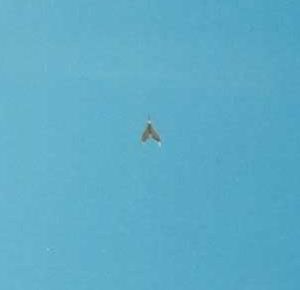
Recovery:
The first flight's glide was a beautiful, gentle spiral. Landing was gentle and
flat. The next three flights ended in death spirals. I'll explore this further
next spring when the temperature is more comfortable.
Summary:
Building an X-21 from scratch is a mildly challenging project, requiring some
thought to fashion suitable elevon control stops and the neutral elevon release
clip.
The X-21 is a work of rocketry art with a stunning and unique look and style. When it glides well, it performs beautifully in all phases of flight. However, if something prevents the elevons from rising to their proper position during glide phase, a death spiral is guaranteed. Luckily, it's a rugged design that survives death spirals with little or no consequence (at least, when its built with yellow and white glues).
Sponsored Ads
 |
 |











